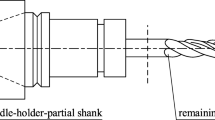Abstract
Chatter can be predicted and avoided through the chatter stability lobe, which is computed by dynamic response (frequency response function) at the tool point. Modal impact testing is time-consuming and inefficient, which is not suitable for tool point dynamic prediction. On the contrary, receptance coupling method can efficiently identify the tool point dynamic by combining the full (translational and rotational) receptance matrix of spindle-holder assembly with numerical or analytical model of any attached free-free tool. Generally, it is difficult to directly obtain the rotational receptances of spindle-holder assembly. This paper proposes an efficient experimental method which deduces the rotational receptances from translational receptances on a single experimental setup by improved receptance coupling technique. One main advantage of this method is to further reduce required impact tests and increase efficiency of tool point dynamic prediction. Besides, a wider application of the proposed method can be achieved. The presented approach is experimentally verified and compared with the state-of-the-art methods.
Similar content being viewed by others
References
Movahhedy MR, Gerami JM (2006) Prediction of spindle dynamics in milling by sub-structure coupling. Int J Mach Tools Manuf 46(3):243–251
Xu C, Zhang JF, Yu DW, Wu ZJ, Feng PF (2015) Dynamics prediction of spindle system using joint models of spindle tool holder and bearings. Proc Inst Mech Eng C J Mech Eng Sci 229(17):3084–3095
Xu C, Feng PF, Zhang JF, Yu DW, Wu ZJ (2017) Milling stability prediction for flexible workpiece using dynamics of coupled ma- chining system. Int J Adv Manuf Technol 90(9–12):3217–3227
Liao JP, Zhang JF, Feng PF, Yu DW, Wu ZJ (2017) Identification of contact stiffness of shrink-fit tool-holder joint based on fractal theory. Int J Adv Manuf Technol 90(5–8):2173–2184
Duncan GS, Tummond MF, Schmitz TL (2005) An investigation of the dynamic absorber effect in high-speed machining. Int J Mach Tools Manuf 45(4–5):497–507
Li ZQ, Wang ZK, Shi XF (2017) Fast prediction of chatter stability lobe diagram for milling process using frequency response function or modal parameters. Int J Adv Manuf Technol 89(9–12):2603–2612
Ewins DJ (2000) Modal testing: theory, practice and application, 2nd edn. Research Studies Press, England
Schmitz TL, Davies MA, Kennedy MD (2001) Tool point frequency response prediction for high-speed machining by RCSA. J Manuf Sci E T ASME 123(4):700–707
Özşahin O, Altintas Y (2015) Prediction of frequency response function (FRF) of asymmetric tools from the analytical coupling of spindle and beam models of holder and tool. Int J Mach Tools Manuf 92:31–40
Filiz S, Cheng CH, Powell KB, Schmitz TL, Ozdoganlar OB (2009) An improved tool–holder model for RCSA tool-point frequency response prediction. Precis Eng 33(1):26–36
Ertürk A, Özgüven HN, Budak E (2006) Analytical modeling of spindle–tool dynamics on machine tools using Timoshenko beam model and receptance coupling for the prediction of tool point FRF. Int J Mach Tools Manuf 46(15):1901–1912
Zhang J, Schmitz T, Zhao WH, Lu BH (2011) Receptance coupling for tool point dynamics prediction on machine tools. Chin J Mech Eng 24(3):340–345
Kivanc EB, Budak E (2004) Structural modeling of end mills for form error and stability analysis. Int J Mach Tools Manuf 44(11):1151–1161
Duarte MLM, Ewins DJ (2000) Rotational degrees of freedom for structural coupling analysis via finite-difference technique with residual compensation. Mech Syst Signal Process 14(2):205–227
Liu Z, Song XL, Zhao YS, Cai LG, Guo HS, Ma JC (2013) Stiffness identification of spindle-toolholder joint based on finite difference technique and residual compensation theory. Adv Mech Eng 5:753631
Schmitz TL, Duncan GS (2005) Three-component receptance coupling substructure analysis for tool point dynamics prediction. J Manuf Sci E T ASME 127(4):781–790
Albertelli P, Goletti M, Monno M (2013) An improved receptance coupling substructure analysis to predict chatter free high speed cutting conditions. Procedia CIRP 12:19–24
Albertelli P, Goletti M, Monno M (2013) A new receptance coupling substructure analysis methodology to improve chatter free cutting conditions prediction. Int J Mach Tools Manuf 72:16–24
Kumar UV, Schmitz TL (2012) Spindle dynamics identification for receptance coupling substructure analysis. Precis Eng 36(3):435–443
Ganguly V, Schmitz TL (2013) Spindle dynamics identification using particle swarm optimization. J Manuf Process 15(4):444–451
Park SS, Altintas Y, Movahhedy M (2003) Receptance coupling for end mills. Int J Mach Tools Manuf 43(9):889–896
Mancisidor I, Urkiola A, Barcena R, Munoa J, Dombovari Z, Zatarain M (2014) Receptance coupling for tool point dynamic prediction by fixed boundaries approach. Int J Mach Tools Manuf 78:18–29
Park SS, Chae J (2008) Joint identification of modular tools using a novel receptance coupling method. Int J Adv Manuf Technol 35(11–12):1251–1262
Montevecchi F, Grossi N, Scippa A, Campatelli G (2016) Improved RCSA technique for efficient tool-tip dynamics prediction. Precis Eng 44:152–162
Özşahin O, Özgüven HN, Budak E (2010) Analysis and compensation of mass loading effect of accelerometers on tool point FRF measurements for chatter stability predictions. Int J Mach Tools Manuf 50(6):585–589
Author information
Authors and Affiliations
Corresponding author
Rights and permissions
About this article
Cite this article
Liao, J., Yu, D., Zhang, J. et al. An efficient experimental approach to identify tool point FRF by improved receptance coupling technique. Int J Adv Manuf Technol 94, 1451–1460 (2018). https://doi.org/10.1007/s00170-017-0957-y
Received:
Accepted:
Published:
Issue Date:
DOI: https://doi.org/10.1007/s00170-017-0957-y



